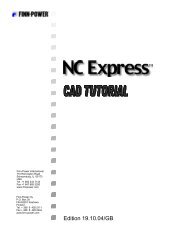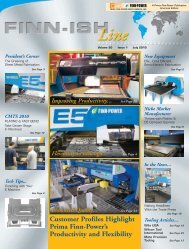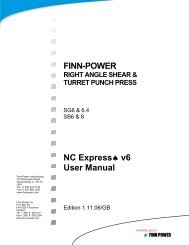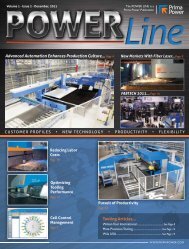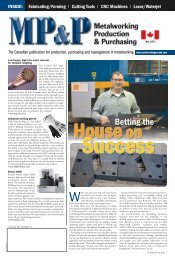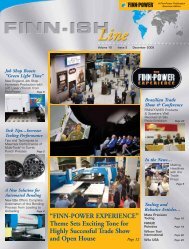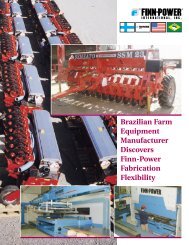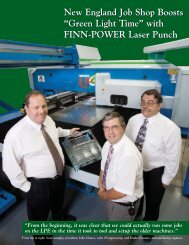Stand-Alone Punch machine user manual - Finn-Power International ...
Stand-Alone Punch machine user manual - Finn-Power International ...
Stand-Alone Punch machine user manual - Finn-Power International ...
You also want an ePaper? Increase the reach of your titles
YUMPU automatically turns print PDFs into web optimized ePapers that Google loves.
tools will have restrictions depending on which type of multi-tool and<br />
which station location within the multi-tool.<br />
Think of a multi-tool as a non-rotary turret within the actual turret.<br />
Stations within a multi-tool are offset from the center point of the<br />
tool, meaning that the location of a tool within the multi-tool will<br />
determine how low the tool hit can be nested or how close the clamp<br />
carriage can move to the turret. Example, if a tool is loaded within a<br />
MT24 multi-tool station 4 (12 o’clock position- furthest tool inside<br />
the turret) and nest under clamps is selected the lowest the tool center<br />
point could be nested is around 0.9” (23mm) using a 0 value for the<br />
bottom margin. This is because the actual turret, thus needing some<br />
protection when nesting low in the Y-axis, restricts the carriage<br />
movement into the turret. If the tool were to be loaded within station<br />
10 (6 o’clock position- outer most position of the turret) it could be<br />
used on the sheet edge if needed.<br />
It is really important when loading the multi-tools within the physical<br />
turret to analyze the most commonly used multi-tools and place these<br />
in the outer most positions (3 o’clock to 9 o’clock) of the multi-tool<br />
turret. This is also true for the top edge of the sheet. If multi-tools<br />
are nested close to the top margin (when <strong>machine</strong> largest Y-axis<br />
value used for plate size) the location of the tool within the multi-tool<br />
will determine how close it will be placed to top edge.<br />
5.1.3.1.2 Manual Clamp Positioning<br />
Defining clamp positions <strong>manual</strong>ly can be done in two different methods.<br />
First, after nesting a plate of parts the clamp positions can be modified by<br />
highlighting the clamp and moving to desired location. Second, by<br />
modifying the clamp location within the nest dialog. When modifying the<br />
clamp locations within the nest dialog a value must be entered for each<br />
clamp available. PIN2 can only be set when the sheet length falls within the<br />
parameter set in the <strong>machine</strong> parameters of NC Express.<br />
When <strong>manual</strong> clamp positions are utilized in the nest it is important to<br />
remember when optimizing that ‘automatic initial clamp positions’, within<br />
the optimizer, is de-activated. This will allow the <strong>manual</strong> clamp settings to<br />
be utilized for the nest. ‘Automatic initial clamp positions’ within the<br />
optimizer finds the optimal clamp locations when optimization is done.<br />
5.1.3.2 Plate Margins<br />
Setting the plate margins is in essence setting the working area within the plate.<br />
Size of plate margins generally varies from company to company, but never is<br />
too small to where parts are very close to the plate edge. Parts being removed<br />
too close to plate edge will create a flimsy skeleton, which can cause problems<br />
at the <strong>machine</strong> or even cause problems for parts.<br />
5-81




